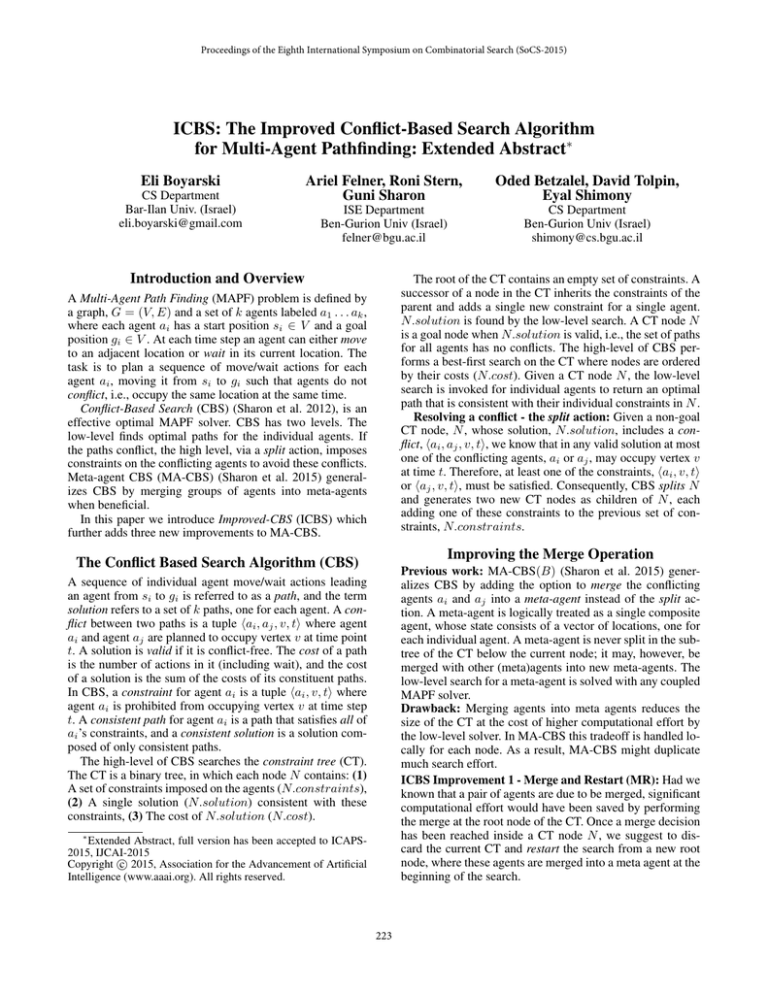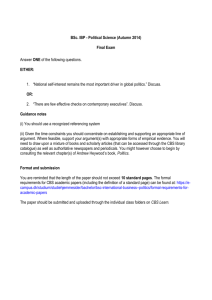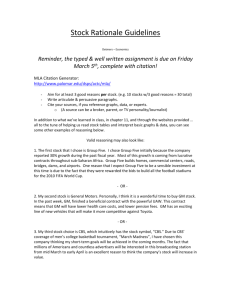
Proceedings of the Eighth International Symposium on Combinatorial Search (SoCS-2015)
ICBS: The Improved Conflict-Based Search Algorithm
for Multi-Agent Pathfinding: Extended Abstract∗
Eli Boyarski
CS Department
Bar-Ilan Univ. (Israel)
eli.boyarski@gmail.com
Ariel Felner, Roni Stern,
Guni Sharon
Oded Betzalel, David Tolpin,
Eyal Shimony
ISE Department
Ben-Gurion Univ (Israel)
felner@bgu.ac.il
CS Department
Ben-Gurion Univ (Israel)
shimony@cs.bgu.ac.il
Introduction and Overview
The root of the CT contains an empty set of constraints. A
successor of a node in the CT inherits the constraints of the
parent and adds a single new constraint for a single agent.
N.solution is found by the low-level search. A CT node N
is a goal node when N.solution is valid, i.e., the set of paths
for all agents has no conflicts. The high-level of CBS performs a best-first search on the CT where nodes are ordered
by their costs (N.cost). Given a CT node N , the low-level
search is invoked for individual agents to return an optimal
path that is consistent with their individual constraints in N .
Resolving a conflict - the split action: Given a non-goal
CT node, N , whose solution, N.solution, includes a conflict, hai , aj , v, ti, we know that in any valid solution at most
one of the conflicting agents, ai or aj , may occupy vertex v
at time t. Therefore, at least one of the constraints, hai , v, ti
or haj , v, ti, must be satisfied. Consequently, CBS splits N
and generates two new CT nodes as children of N , each
adding one of these constraints to the previous set of constraints, N.constraints.
A Multi-Agent Path Finding (MAPF) problem is defined by
a graph, G = (V, E) and a set of k agents labeled a1 . . . ak ,
where each agent ai has a start position si ∈ V and a goal
position gi ∈ V . At each time step an agent can either move
to an adjacent location or wait in its current location. The
task is to plan a sequence of move/wait actions for each
agent ai , moving it from si to gi such that agents do not
conflict, i.e., occupy the same location at the same time.
Conflict-Based Search (CBS) (Sharon et al. 2012), is an
effective optimal MAPF solver. CBS has two levels. The
low-level finds optimal paths for the individual agents. If
the paths conflict, the high level, via a split action, imposes
constraints on the conflicting agents to avoid these conflicts.
Meta-agent CBS (MA-CBS) (Sharon et al. 2015) generalizes CBS by merging groups of agents into meta-agents
when beneficial.
In this paper we introduce Improved-CBS (ICBS) which
further adds three new improvements to MA-CBS.
Improving the Merge Operation
The Conflict Based Search Algorithm (CBS)
Previous work: MA-CBS(B) (Sharon et al. 2015) generalizes CBS by adding the option to merge the conflicting
agents ai and aj into a meta-agent instead of the split action. A meta-agent is logically treated as a single composite
agent, whose state consists of a vector of locations, one for
each individual agent. A meta-agent is never split in the subtree of the CT below the current node; it may, however, be
merged with other (meta)agents into new meta-agents. The
low-level search for a meta-agent is solved with any coupled
MAPF solver.
Drawback: Merging agents into meta agents reduces the
size of the CT at the cost of higher computational effort by
the low-level solver. In MA-CBS this tradeoff is handled locally for each node. As a result, MA-CBS might duplicate
much search effort.
ICBS Improvement 1 - Merge and Restart (MR): Had we
known that a pair of agents are due to be merged, significant
computational effort would have been saved by performing
the merge at the root node of the CT. Once a merge decision
has been reached inside a CT node N , we suggest to discard the current CT and restart the search from a new root
node, where these agents are merged into a meta agent at the
beginning of the search.
A sequence of individual agent move/wait actions leading
an agent from si to gi is referred to as a path, and the term
solution refers to a set of k paths, one for each agent. A conflict between two paths is a tuple hai , aj , v, ti where agent
ai and agent aj are planned to occupy vertex v at time point
t. A solution is valid if it is conflict-free. The cost of a path
is the number of actions in it (including wait), and the cost
of a solution is the sum of the costs of its constituent paths.
In CBS, a constraint for agent ai is a tuple hai , v, ti where
agent ai is prohibited from occupying vertex v at time step
t. A consistent path for agent ai is a path that satisfies all of
ai ’s constraints, and a consistent solution is a solution composed of only consistent paths.
The high-level of CBS searches the constraint tree (CT).
The CT is a binary tree, in which each node N contains: (1)
A set of constraints imposed on the agents (N.constraints),
(2) A single solution (N.solution) consistent with these
constraints, (3) The cost of N.solution (N.cost).
∗
Extended Abstract, full version has been accepted to ICAPS2015, IJCAI-2015
c 2015, Association for the Advancement of Artificial
Copyright Intelligence (www.aaai.org). All rights reserved.
223
MR is simple to implement, and saves much of the effort
duplicated in the multiple CT nodes. In most cases the gains
outweigh the additional overhead. As it is very hard to model
these quantities theoretically, we tested MR empirically, and
indeed it speeds up the search by a significant factor.
Improving the Split Operation
ICBS Improvement 2 - Prioritize Conflicts (PC): CBS arbitrarily picks a conflict for splitting, and its performance is
very sensitive to the conflicts chosen, as these can significantly influence the number of CT nodes.
We distinguish between three types of conflicts: Cardinal
conflict. A conflict C = ha1 , a2 , v, ti is cardinal for a CT
node N if adding any of the two constraints derived from
C (ha1 , v, ti, ha2 , v, ti) to N and invoking the low-level on
the constrained agent, the cost of its path is increased when
compared to its cost in N . A conflict C is semi-cardinal for
a CT node N if adding one of the two constraints derived
from C increases N.cost but adding the other leaves N.cost
unchanged. A conflict is non cardinal for a CT node N if
neither of the constraints derived from C increases N.cost.
When a node N with N.cost = c is chosen for expansion
by CBS, we examine all its conflicts. If a cardinal conflict
is encountered, it is immediately chosen for the split action.
This generates two children with cost > c. In this case if
another node N 0 in OPEN has cost c, then N 0 can be immediately chosen for expansion next without further developing
nodes below N . If no cardinal conflicts exist, the next preference is to choose semi-cardinal conflicts. Here, we know
that at least the cost of one child will immediately increase.
If only non-cardinal conflicts exist, one is chosen arbitrarily.
Figure 1: Comparison of all algorithms, DAO maps
Experimental Results
We fine-tuned a number of leading algorithms with
the best parameters. We compare ICBS(25) (=MACBS(25)+BP+PC+MR), to the following other MAPF
solvers: (1) MA-CBS(25)+BP, the former best CBS variant. (2) MA-CBS(25) (3) EPEA* (Goldenberg et al. 2014),
an enhanced version of A* designed for cases with large
branching factors, the best A* variant. (4) ICTS+p (Sharon
et al. 2013), the best ICTS variant.
Figure 1 presents the success rate (left) and runtime
(right) for the three standard benchmark maps (brc202d:top,
ost003d:middle, den520d:bottom) of the game Dragon Age:
Origins (DAO) (Sturtevant 2012) that were used by Sharon
et al. (2013; 2015), 100 instances per map.
In all three maps, ICBS is clearly the best CBS variant.
ICBS’ runtime is also the best amongst the ones compared
here. ICBS is also the best in success rate for brc202d and
for den520d, while ICBS, EPEA* and ICTS are tied in the
success rate in ost003d .
ICBS Improvement 3 - Bypassing Conflicts (BP): CBS is
sensitive to the paths found by the low level. BP provides a
way to bypass conflicts by modifying the chosen path of one
of the agents, thereby preventing a split and reducing the CT.
For each CT node N we use N.N C to denote the total
number of conflicts of the form hai , aj , v, ti between the
paths in N.solution. A path Pi0 is a valid bypass to path
Pi for agent ai with respect to a conflict C = hai , aj , v, ti
and a CT node N , if: (i) Unlike Pi , Pi0 does not include conflict C, (ii) cost(Pi0 ) = cost(Pi ) and (iii) Pi and Pi0 are both
consistent with N.constraints.
Adopting path Pi0 by a CT node N means replacing Pi
with a valid bypass Pi0 for agent ai . Adopting a valid bypass
may introduce more conflicts compared to the original path
and potentially lead to worse overall runtime. Thus, we only
allow adopting helpful bypasses that reduce N.N C.
For a given CT node N , BP peeks at either of the immediate children of N in the CT. If the path of a child includes
a helpful bypass for the conflict of N , this path is adopted
by N without splitting N and adding new nodes to the CT.
This can potentially save a significant amount of search due
to a smaller size CT. Valid bypasses can only be found for
semi- or non-cardinal conflicts and not for cardinal conflicts.
Therefore if PC found a cardinal conflict BP is skipped.
Conclusions and Future Work
ICBS is the best solver on standard benchmarks, or ties with
other solvers. Future work will further study the relations between these enhancements, find a better merge policy than a
fixed B parameter and study the pros and cons of the various
MAPF algorithms under different circumstances.
References
Goldenberg, M.; Felner, A.; Stern, R.; Sharon, G.; Sturtevant, N. R.; Holte, R. C.; and Schaeffer, J. 2014. Enhanced
partial expansion A. J. Artif. Intell. Res. (JAIR) 50:141–187.
Sharon, G.; Stern, R.; Felner, A.; and Sturtevant, N. R. 2012.
Conflict-based search for optimal multi-agent path finding.
In AAAI.
224
Sharon, G.; Stern, R.; Goldenberg, M.; and Felner, A. 2013.
The increasing cost tree search for optimal multi-agent
pathfinding. Artif. Intell. 195:470–495.
Sharon, G.; Stern, R.; Felner, A.; and Sturtevant, N. R. 2015.
Conflict-based search for optimal multi-agent path finding.
Artificial Intelligence Journal (AIJ) 218:40–66.
Sturtevant, N. 2012. Benchmarks for grid-based pathfinding. Transactions on Computational Intelligence and AI in
Games 4(2):144 – 148.
225




